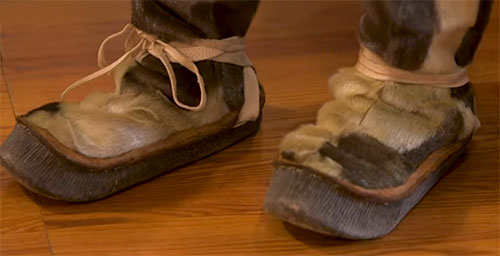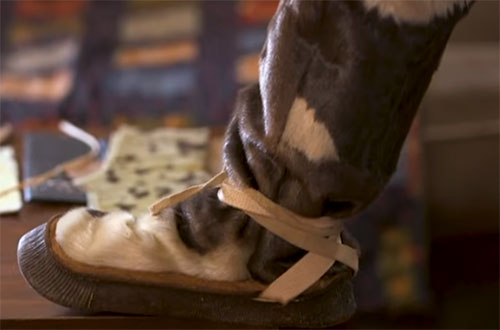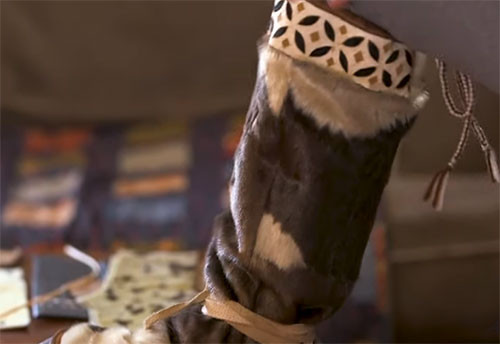 Inuit people traditionally made practically all of their clothing, footwear, and accessories from animal skins and fur – simply because it was pretty much impossible to import fabrics or grow such plants as flax, hemp, cotton, etc in Alaska. And the weather in the northern regions is very cold, so only wool and fur were able to protect the body. Inuit traditional shoes look great and are extremely warm – much warmer than any modern materials. Let’s see how this footwear is made.
Inuit people traditionally made practically all of their clothing, footwear, and accessories from animal skins and fur – simply because it was pretty much impossible to import fabrics or grow such plants as flax, hemp, cotton, etc in Alaska. And the weather in the northern regions is very cold, so only wool and fur were able to protect the body. Inuit traditional shoes look great and are extremely warm – much warmer than any modern materials. Let’s see how this footwear is made.
Working with animal skins demands a lot of attention, skill, time, and hard work. You have to catch an animal, skin it, wash and prepare the skin, stretch-dry it, and only after all this, you can sew the clothes out of it. But Inuits didn’t have much of a choice, so they learned to work with fur and leather skillfully.
The traditional Inuit shoes made from seal or reindeer skin are called “mukluks” or “kamik”. They are soft, usually high (about knee-height), and warm, with a soft leather sole. This footwear is super comfy. It protects your feet from the cold, but also, you can easily walk, tip-toe, run, hunker down, and so on in these shoes. Inuit hunters could move very quietly in mukluks.
Also, mukluks weigh little, they don’t need any lacing (though, sometimes they can be laced), zippers, or buttons – you just tug them on like socks. Another useful feature is their breathability, thanks to which your feet aren’t constantly wet (obviously, a very bad thing in a cold climate).

So, Inuit mukluks are great shoes, perfect for Alaska and the neighboring territories. But how are they made?
The work begins from a sole. First of all, the template is drawn and cut out of cardboard (even the sole of your favorite comfy shoes can be encircled). The future owner can put a foot onto the template and check if the size is right. A few inches are added along the edges for the side of the sole because it isn’t flat. After that, the template is encircled on a piece of leather that will serve as a flexible but durable sole.
All the hair (seal or reindeer fur) is removed from the leather sole, which is a long and labor-intensive process. Traditionally Inuits used sand to quicken the work. The pieces of leather are washed again and prepared for the next step.
This step is very important and interesting. The sides of a sole are crimped to make tiny pleats all around – this will be the side of the sole. Today, the crimps are made with pliers, but in the past, people chewed the leather sole to make these crimps – poor teeth!

And then, the bootlegs are sewn from fur or leather. There are winter mukluks (with thick fur) and summer mukluks (with thin bootlegs that protect from moist rather than cold).

Also, mukluks can be simple, with no adornments, just working boots. But some samples are richly decorated with embroidery, applique, decorative lacing, tiny pendants hanging from a bootleg, etc. People have always wanted to make their clothes beautiful, not just functional. So, there are dozens of different designs of mukluks. The height, size, style, and amount of decoration depended on the season, available leather piece, region of origin, occasion, and taste of the owner aka artisan (most people produced their own mukluks or the footwear for their family, there were no clothing stores to buy shoes).
When the mukluks were ready, the happy owner wore them and could comfortably walk around in these handy, warm, and charming-looking shoes.
The old craft of making mukluks has almost disappeared when factory-made shoes became available. But nowadays, a few Inuit craftsmen are popularizing mukluks and teaching the youth to make them, so the craft is reviving and people are retrieving their heritage and clothing traditions. And that’s great.
Photos are from: https://www.youtube.com/watch?v=MDjJYE0tmFQ


